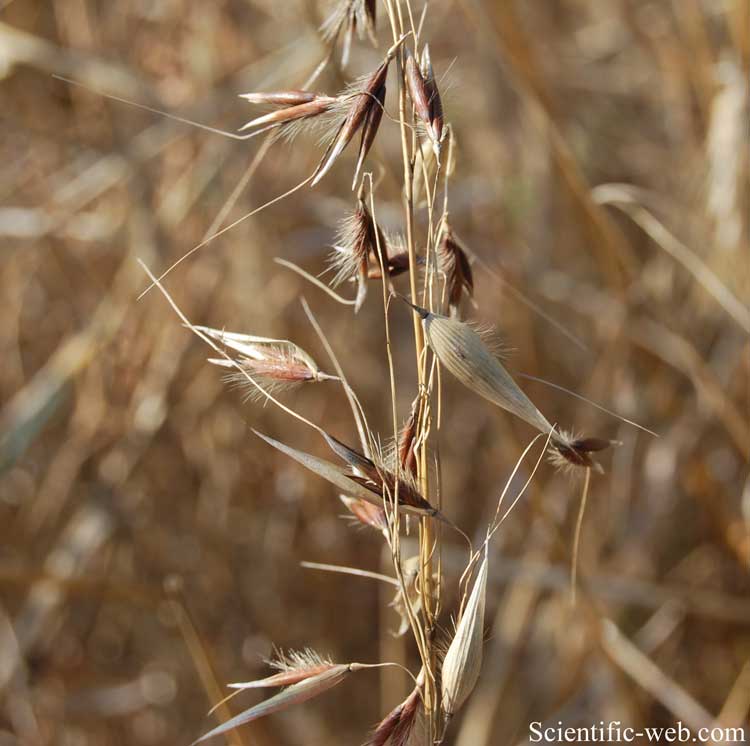
Avena fatua, Photo: Michael Lahanas
Classification System: APG IV
Superregnum: Eukaryota
Regnum: Plantae
Cladus: Angiosperms
Cladus: Monocots
Cladus: Commelinids
Ordo: Poales
Familia: Poaceae
Subfamilia: Pooideae
Tribus: Aveneae
Subtribus: Aveninae
Genus: Avena
Species: Avena fatua
Name
Avena fatua L.
References
USDA, NRCS. 2006. The PLANTS Database, 6 March 2006 (http://plants.usda.gov). Data compiled from various sources by Mark W. Skinner. National Plant Data Center, Baton Rouge, LA 70874-4490 USA.
Linnaeus, C. 1753. Species Plantarum. Tomus I: 80. Reference page.
USDA, ARS, Germplasm Resources Information Network. Avena fatua in the Germplasm Resources Information Network (GRIN), U.S. Department of Agriculture Agricultural Research Service.
Vernacular names
беларуская: Аўсюк
Deutsch: Flug-Hafer
español: Avena loca
eesti: Tuulekaer
suomi: Hukkakaura
français: Folle avoine
Gàidhlig: Coirce-fiadhain
galego: Avea louca
norsk: Floghavre
polski: Owies głuchy
русский: Овсюг
Türkçe: Yabani yulaf
中文(简体): 野燕麦
中文(繁體): 野燕麥
Avena fatua is a species of grass in the oat genus. It is known as the common wild oat. This oat is native to Eurasia but it has been introduced to most of the other temperate regions of the world. It is naturalized in some areas and considered a noxious weed in others.[2][3][4]
Avena fatua is a typical oat in appearance, a green grass with hollow, erect stems 1 to 4 feet (30–120 cm) tall bearing nodding panicles of spikelets. The long dark green leaves are up to a centimeter wide and rough due to small hairs. The seedlings are also hairy. The seed kernel is thinner, longer, darker and hairy when compared with the seed of the common cultivated oat (Avena sativa). This species and other wild oats can become troublesome in prairie agriculture when it invades and lowers the quality of a field crop, or competes for resources with the crop plants. It takes very few wild oat plants to cause a significant reduction in the yield of a wheat or cultivated oat field, even though the seeds are a type of oat.[5][6]
References
The Plant List, Avena fatua L.
Adolfo María, H. 1966. Nómina de las plantas recolectadas en el valle de Cochabamba 2: 1–86. Colegio La Salle, Cochabamba
Burkart, A. E. 1969. Gramíneas. 2: 1–551. In A. E. Burkart (ed.) Flora Ilustrada de Entre Ríos. Instituto Nacional de Tecnología Agropecuaria, Buenos Aires
Cabi, E. & M. Doğan. 2012. Poaceae. 690–756. In A. Güner, S. Aslan, T. Ekim, M. Vural & M. T. Babaç (eds.) Türkiye Bitkileri Listesi. Nezahat Gökyiğit Botanik Bahçesi ve Flora Araştırmaları Derneği Yayını
Moore, D. M. 1968. The vascular flora of the Falkland Islands. British Antarctic Survey Scientific Reports 60: 1–202, 1–6 pls
Welsh, S. L. 1974. Anderson's Flora of Alaska and Adjacent Parts of Canada i–xvi, 1–724. Brigham Young University Press, Provo
Retrieved from "http://en.wikipedia.org/"
All text is available under the terms of the GNU Free Documentation License

